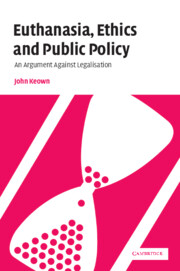Book contents
- Frontmatter
- Contents
- Preface
- Foreword
- Acknowledgments
- Table of cases
- List of abbreviations
- Introduction
- PART I Definitions
- PART II The ethical debate: human life, autonomy, legal hypocrisy, and the slippery slope
- PART III The Dutch experience: controlling VAE? condoning NVAE?
- 8 The guidelines
- 9 The first Survey: the incidence of ‘euthanasia’
- 10 Breach of the guidelines
- 11 The slide towards NVAE
- 12 The second Survey
- 13 The Dutch in denial?
- PART IV Australia and the United States
- PART V Expert opinion
- PART VI Passive euthanasia: withholding/withdrawing treatment and tube-feeding with intent to kill
- Conclusions
- Afterword
- Bibliography
- Index
13 - The Dutch in denial?
Published online by Cambridge University Press: 20 July 2009
- Frontmatter
- Contents
- Preface
- Foreword
- Acknowledgments
- Table of cases
- List of abbreviations
- Introduction
- PART I Definitions
- PART II The ethical debate: human life, autonomy, legal hypocrisy, and the slippery slope
- PART III The Dutch experience: controlling VAE? condoning NVAE?
- 8 The guidelines
- 9 The first Survey: the incidence of ‘euthanasia’
- 10 Breach of the guidelines
- 11 The slide towards NVAE
- 12 The second Survey
- 13 The Dutch in denial?
- PART IV Australia and the United States
- PART V Expert opinion
- PART VI Passive euthanasia: withholding/withdrawing treatment and tube-feeding with intent to kill
- Conclusions
- Afterword
- Bibliography
- Index
Summary
The increasing body of evidence which has emerged from the Netherlands over the past fifteen or so years, not least the wealth of data produced by the two surveys, shows that the guidelines have been extensively breached and that there has been a marked lack of control by the authorities. Yet the disturbing reality of inadequate control still seems lost on many. As we saw in the Introduction to this book, even one of the Justices of the US Supreme Court who was referred to the leading exposés of Dutch practice nevertheless thought that the picture from the Netherlands was still unclear and that further evidence was needed. Why such hesitation given the mass of disturbing evidence already in the public domain?
One reason is that the Dutch (and non-Dutch) supporters of VAE have often, not surprisingly, placed a misleadingly benign interpretation on the evidence. They have persistently sought to portray the Dutch experience in the best possible light, denying or at least downplaying its negative aspects. This is predictable but not productive and has inevitably served to muddy the waters. In particular, anyone who had uncritically read the benign interpretation of the data either by Professor Van der Maas or by the Remmelink Commission could be forgiven for thinking that VAE was under effective control.
Van der Maas and Remmelink
As we have seen, Van der Maas concluded that his surveys showed that decision-making by Dutch doctors was of high quality and that they were prepared to account for their conduct.
- Type
- Chapter
- Information
- Euthanasia, Ethics and Public PolicyAn Argument Against Legalisation, pp. 136 - 150Publisher: Cambridge University PressPrint publication year: 2002

